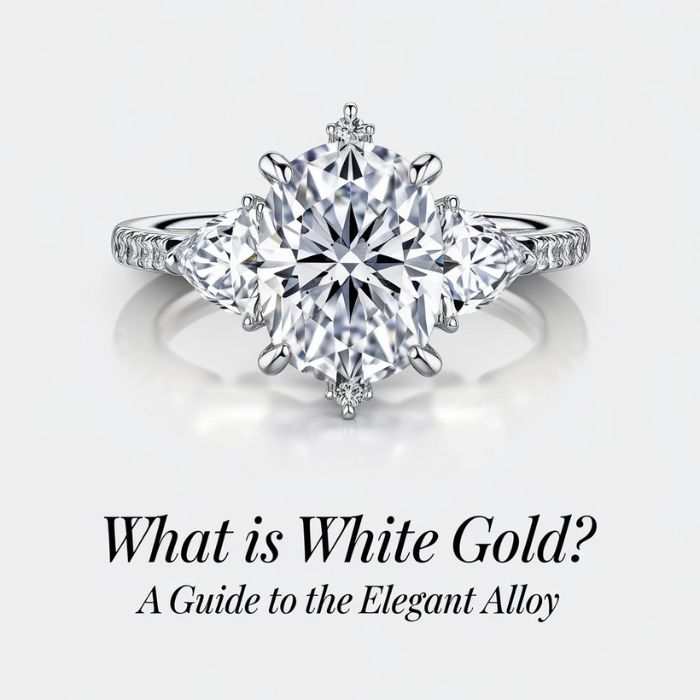White gold is one of the most popular choices for fine jewelry, known for its sleek, modern look and versatility. From engagement rings to bracelets, golden white is loved for its silvery-white finish that resembles platinum or silver but comes with the durability and timeless appeal of gold. But what exactly is golden white? Is it pure gold, or is there something more to its shimmering, lustrous appearance?
In this article, we’ll dive into everything you need to know about golden white—what it’s made of, how it’s crafted, and why it’s become a favorite in the world of jewelry. Whether you’re considering a golden white ring or simply curious about its composition, you’ll find all your answers here.
What Is White Gold?
golden white is an alloy, meaning it is not pure gold. Instead, it’s a mixture of yellow gold and other metals that create a silvery-white hue. Unlike yellow gold, which retains its natural golden color, golden white undergoes a transformation by being combined with white-colored metals like palladium, nickel, or silver. The result is a light-colored, radiant metal that is both strong and beautiful.
While it’s often thought of as a “color” of gold, golden white is actually created through a sophisticated process of alloying, designed to make it more durable and achieve that striking white finish. golden white has a similar luster to platinum, but it’s generally more affordable and offers a different aesthetic appeal.
What Is White Gold Made Of?
golden white starts with pure gold, which is naturally yellow in color. To turn it into golden white, jewelers mix it with various white metals. The metals most commonly used to alloy with yellow gold include:
- Palladium: This metal is prized for its durability and contributes to a golden white bright, silver-like appearance. Palladium is also hypoallergenic, making it ideal for people with sensitive skin.
- Nickel: Nickel is another commonly used metal in golden white, giving it strength and a white hue. However, some people are allergic to nickel, so it’s important to check with the jeweler if you have sensitive skin.
- Silver: Adding silver helps brighten the overall color and keeps the gold malleable for easy crafting into intricate designs.
The ratio of these metals to gold determines the karat of the golden white. For example, 18K golden white contains 75% pure gold, while 14K golden white contains 58.3% pure gold. The higher the gold content, the more yellowish the alloy might appear without additional treatments.
The Rhodium Plating Process
One thing many people don’t realize is that golden white doesn’t always appear purely white on its own, even after alloying. It often has a slightly yellowish or off-white tint due to the natural color of gold. To achieve that perfect silvery-white shine, golden white is typically coated with a layer of rhodium, a metal from the platinum family known for its bright, reflective finish.
Rhodium plating not only enhances the color of golden white but also increases its scratch resistance and overall durability. However, over time, the rhodium plating can wear off, revealing the slightly yellowish color underneath. Fortunately, most jewelers offer re-plating services to restore the original shine.
White Gold vs. Yellow Gold vs. Rose Gold
Gold comes in many forms, with yellow, white, and rose being the most popular. Here’s how golden white compares to its counterparts:
- White Gold: Mixed with metals like nickel or palladium to achieve its white hue, golden white is often plated with rhodium for extra shine. It offers a modern, sleek appearance and is favored for engagement rings and other fine jewelry.
- Yellow Gold: This is gold in its most traditional form, alloyed with copper and zinc to strengthen it while maintaining its natural colour. Yellow gold is classic, and many people prefer it for its warmth and historical association with luxury.
- Rose Gold: Rose gold gets its distinct pinkish-red hue from copper. It has become increasingly popular in recent years due to its vintage charm and romantic feel.
Is White Gold Real Gold?
Yes, golden white is real gold. The term “golden white” refers to the alloy created by mixing pure yellow gold with other metals, but the gold content remains genuine. The karat rating (e.g., 14K or 18K) indicates how much of the alloy is made up of pure gold.
For example, 18K golden white contains 75% gold, while 14K golden white contains 58.3% gold. The remaining percentage consists of the white metals used to achieve the alloy’s color and strength.</p>
Is White Gold Hypoallergenic?
Not all golden white is hypoallergenic. If the alloy contains nickel, it may cause allergic reactions in people with nickel sensitivity. For those prone to allergies, it’s best to choose golden white made with palladium or other hypoallergenic metals instead of nickel. You can always ask your jeweller about the specific composition of the golden white to avoid any issues.
Caring for White Gold Jewelry
golden white is durable, but it still requires proper care to maintain its appearance over time. Here are a few tips for keeping your golden white jewelry looking its best:
- Avoid Harsh Chemicals: Exposure to chemicals like chlorine, bleach, or cleaning products can damage the rhodium plating on golden white. Remove your jewelry before using household cleaners or swimming in chlorinated pools.
- Regular Cleaning: Clean your golden white jewelry with a mild soap and warm water solution. Use a soft cloth or a jewelry-specific polishing cloth to gently clean the surface.
- Rhodium Replating: Over time, the rhodium plating on golden white can wear away, causing the jewelry to appear less shiny or slightly yellowish. If this happens, you can have your jewelry re-plated by a jeweler to restore its bright white finish.
- Store Carefully: To avoid scratches and tarnishing, store golden white jewelry in a soft pouch or jewelry box away from other metal pieces.
How Is White Gold Priced?
The price of golden white is typically based on three factors:
- Gold Content: Higher karat golden white (e.g., 18K) will be more expensive than lower karat options like 14K or 10K because it contains a higher percentage of pure gold.
- Metals Used: Palladium-based golden white tends to be more expensive than nickel-based golden white due to the cost of palladium.
- Craftsmanship and Design: Intricate designs or custom pieces will increase the cost, as will added elements like diamonds or other precious stones.
It’s worth noting that while golden white is more affordable than platinum, it can still be a significant investment, particularly when paired with high-quality stones in fine jewelry.
Is White Gold a Good Investment?
golden white, like any form of gold, holds intrinsic value due to its gold content. However, the value of golden white jewelry typically doesn’t appreciate as much as pure gold bars or coins. The primary value of golden white comes from its beauty and use in jewelry rather than as an investment commodity. If you’re looking for a precious metal that will retain value over time, platinum or gold bullion may be better choices.
That said, golden white is an excellent choice for engagement rings, wedding bands, and other sentimental jewelry pieces because of its stunning appearance and relative durability.
FAQs
Is white gold more expensive than yellow gold?
golden white and yellow gold are usually priced similarly when comparing pieces with the same karat rating. However, additional factors like rhodium plating and the metals used for alloying may slightly increase the cost of golden white.
Does white gold tarnish?
golden white doesn’t tarnish in the same way that silver does, but the rhodium plating can wear off over time, giving the jewellery a duller appearance. Regular maintenance, such as rhodium re-plating, will keep golden white looking its best.
How often should I re-plate my golden white jewellery?
It depends on how often you wear the piece, but most people need to re-plate their golden white jewelry every 1-3 years to maintain its bright, shiny appearance.
Can golden white turn yellow?
golden white may develop a yellowish tint over time as the rhodium plating wears away, revealing the underlying gold alloy. Regular re-plating can prevent this.
Is golden white better than platinum?
Both metals have their advantages. Platinum is more durable and hypoallergenic but is generally more expensive than golden white. golden white, with its rhodium plating, offers a similar look at a more affordable price but may require more maintenance.
Is golden white a good choice for engagement rings?
Absolutely! golden white is a popular and stylish choice for engagement rings because of its elegant appearance, durability, and affordability compared to platinum.
Conclusion
White gold is a beautiful, versatile metal that combines the elegance of gold with the sleek, modern look of silver or platinum. Whether you’re considering golden white for an engagement ring, wedding band, or any other type of fine jewelry, understanding its composition, care, and value will help you make an informed decision. With proper care and occasional re-plating, golden white can retain its brilliance and charm for years to come.











